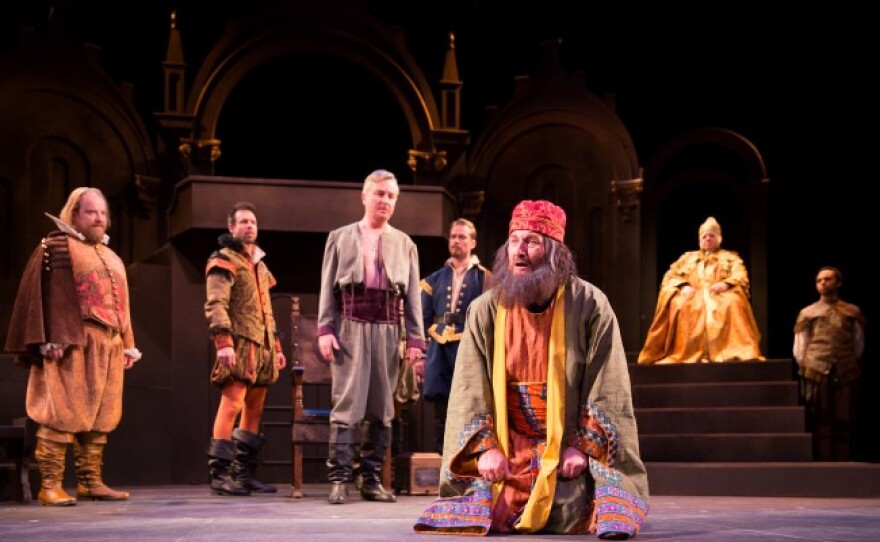In March, for the first time, the Heart of America Shakespeare Festival staged a production not at Southmoreland Park in Midtown Kansas City, Missouri, but indoors, at Johnson County Community College’s Polsky Theatre.
Working without having to worry about rain, bugs, and people walking their dogs made the festival’s typical technical challenges a breeze, says executive artistic director Sidonie Garrett.
“Johnson County Community College has a professional technical director and crew people who run the flies and sound and lights, and they have great equipment," Garrett says. "It was everything a professional company would want it to be.”
The show, The Merchant of Venice, nearly sold out every night. It included a talk-back afterwards, and many audience members stayed to discuss the play’s anti-Semitic themes. Garret says she could tell the audience was “performance savvy” because of the breadth and depth of their questions.
That engaged attitude in a Johnson County audience shouldn’t come as a surprise. According to numbers collected by ArtsKC, the metro’s regional arts council, Johnson Countians are in the top 4 percent nationwide when it comes to going to theater productions, gallery openings, live music performances, and other cultural events.

Still, there's a stereotype that Johnson County lacks culture, says Sarah VanLanduyt, executive director of theArts Council of Johnson County. She couldn’t disagree more.
“There’s wonderful things happening in Olathe, in Leawood, in downtown Overland Park, and at the Merriam art gallery,” she notes.
VanLanduyt’s organization partners with about 70 non-profit Johnson County arts groups to find sponsorship and resources.
Support for the arts from VanLanduyt’s group, local municipalities, and community members is evident in Johnson County. Sculptures line Roe Boulevard as a result of Roeland Park’s public art program. Galleries and arts-related businesses dot shopping centers.
Meanwhile, in Wyandotte County, there's no such infrastructure for the arts. Wyandotte County has about half the number of for-profit and non-profit arts organizations per capita as Johnson County.

One of the largest arts groups in Wyandotte is Alcott Arts Center, a three-story former school building just off 18th street and I-70 in Kansas City, Kansas. Alcott hosts gallery showings, plays, and community art classes for toddlers to senior citizens. Last Halloween, it welcomed 600 Kansas City, Kansas, kids to a super-hero-themed trick-or-treat. The building is loaded with historic 1920s charm — but it also lacks heat, which means it stays closed during the winter.
Director Chris Green has been seeking funds for heat since Alcott opened more than a decade ago. But, $55,000 for a new boiler and ductwork stands in the way of the center becoming a functional space year-round. A donor is poised to match the remaining money for a new boiler if Alcott can raise the first $25,000.
Rather than relying on public or grant funding, Alcott operates on money raised by its own fundraisers, says Chuck Green, Chris’s husband and another Alcott co-founder.
“If you have a political change, kind of like our state government, when (Gov. Sam) Brownback did away with the Kansas Arts Commission, then at that point, so many places folded. For us, we wanted to make sure the place was here whether anybody got paid here or not, we still created art,” says Chuck Green.
Another Wyandotte County arts group is taking advantage of grant funding. FOKL, a music venue in the graffiti-painted basement of an upholstery shop on Central Avenue, has funding from New York City's Robert Rauschenberg Foundation to cover basic expenses until 2018. About a dozen artists and musicians volunteer there to host art shows and concerts.
FOKL co-founder Martin Swank still thinks it is easier to get art projects funded in Johnson County.
“There might just be a different mind set in Johnson County," he says. "There’s more money there to flow into the arts. Even if it’s not coming in from the state, it’s in the community. A lot of Wyandotte County, at least this area, it’s just working class, like paycheck to paycheck, from what I’ve seen.”

The portion of those paychecks that people give to the arts in Johnson County is much greater: Johnson Countians spend about twice as much on the arts as residents of Wyandotte County.
But FOKL is an example of how the number of arts non-profits and creative businesses in Wyandotte has been rising since 2009. Swank and his colleagues have plans to open a new community center just a few blocks down Central Avenue. And, Alcott Arts Center is installing more than 100 new windows that will lock in the heat from their new boiler they anticipate being able to buy in the next year.
This look at the Missouri-Kansas state line is part of KCUR's months-long examination of how geographic borders affect our daily lives in Kansas City. KCUR will go Beyond Our Borders and spark a community conversation through social outreach and innovative journalism.
We will share the history of these lines, how the borders affect the current Kansas City experience and what’s being done to bridge or dissolve them. Be a source for Beyond Our Borders: Share your perspective and experiences on the state line with KCUR.














